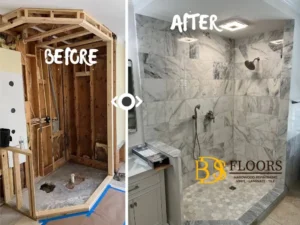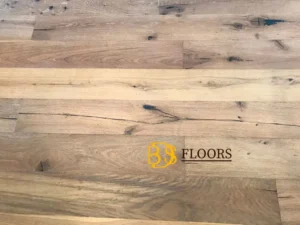Installing hardwood flooring is a classic choice that offers durability, versatility, and can increase the value of a property. It’s a great option if you’re considering updating your home’s floors, but it’s important to work with a professional installation service to ensure your desired outcome is achieved. If you have questions or concerns about hardwood floor installation, we’ve provided some answers to common inquiries to help you feel more informed and confident moving forward.
To properly handle and store your wood flooring before installation, it’s important to keep it in a dry environment. If possible, avoid unloading the flooring in rainy weather to prevent excess moisture from causing the wood to shrink and potentially ruin the entire floor.
After unloading, let the flooring acclimate for a few days in the room where it will be installed.
As for where you can install hardwood flooring, it’s possible to install it in any room of the house with the variety of products and installation techniques available today. The main consideration is whether the floor will be above or below ground level. Solid hardwood is not recommended for below-grade installations, such as in basements, due to potential moisture issues. In this case, engineered hardwood is a better option as it is naturally dimensionally stable. However, on/above-grade installations with solid hardwood are possible.
If you’re wondering about solid wood flooring installation, there are a few key considerations to keep in mind.
Firstly, it is possible to install solid wood over linoleum as long as the linoleum is firmly adhered to the subfloor.
When it comes to stairs, solid wood can be installed, but it’s important to consider safety as it can be slippery, especially if you have young children or pets in the house.
As for the most effective installation method, it depends on factors such as the type of product, location, and subfloor. The three main types of installation are nail down, glue down, and floating.
Floating flooring involves laying the planks over a layer of underlay and gluing them together instead of attaching them to a permanent subfloor. This method is commonly used for laminate flooring but is not recommended for solid wood.
When installing real wood to a subfloor, a 15mm expansion space towards the walls is recommended. For hanging installations, there should be a 5mm gap between the flooring and wall for every meter of installation width, as well as a 15mm expansion gap lengthwise.

When it comes to estimating how much waste to anticipate during the flooring installation process, it’s important to keep in mind that clients may encounter material-specific irregularities that need to be removed during on-site selection and installation. As a general rule, it’s recommended to add 7-10% to the total square footage of the room for scrap cutting.
Another factor to consider is the impact of sunlight on the flooring over time. While the color of any type of wood will inevitably change, the extent and nature of this change will vary depending on the specific kind of wood. Light-colored woods may not necessarily become lighter over time, while dark woods will tend to darken. Each type of wood has its own unique aging process and will respond to sunlight in its own way.
If you’re considering hiring a hardwood flooring company to install new floors in your home, there are a few important factors to keep in mind. Firstly, make sure that the installers are licensed to work in your area, as hiring unlicensed contractors can lead to issues such as invalidating your warranty.
In addition, it’s essential to ensure that the contractor is fully insured, as this will protect you in case any damage occurs during the installation process.
When it comes to warranties, most contractors will offer at least a one-year guarantee for their hardwood flooring installation services. However, it’s a good idea to ask multiple contractors about their warranties to get a sense of what’s standard in the industry and what might constitute a better value.
Finally, it’s important to inquire about the estimated timeframe for installation. This includes not only the time it will take to install the new hardwood floors, but also any necessary steps such as removing old flooring or relocating furniture. By asking these questions upfront, you can ensure that the installation process runs smoothly and that you’re fully prepared for any potential disruptions.
5 Questions to Ask When Considering a Wood Flooring Installation
To ensure a successful custom wood flooring installation, trust is a crucial factor to consider when choosing a contractor. Without trust, the process can be unpredictable and may end up being a disaster. To help you make a sound decision and simplify the process, there are five vital questions to ask when evaluating a wood flooring installer.
Inquire about the opinions of others who have used the service, and obtain at least three references. It is recommended to follow up on these references and ask questions to ensure their validity. Websites such as Yelp, Google, and Angie’s List are excellent resources for learning about the experiences of homeowners who have had wood flooring installed by the chosen company. A few negative reviews are not necessarily concerning, as a trustworthy contractor will generally have overwhelmingly positive feedback. Pay attention to how the company responds to and handles any complaints in a professional manner.
Before agreeing to a wood flooring installation contract, customers should be aware of what is included. While a contractor should be transparent about any possible issues that may arise prior to starting work, some problems may only become apparent once the floor is dismantled for installation. It is recommended to set aside contingency funds just in case.

Inquire about the expected duration of a wood flooring installation project and what will happen if unexpected issues arise. It is essential to understand lead times for ordering and delivering the necessary products and services and when the contractor is available to start the project. Understanding the project’s timeline can help customers feel more comfortable with the installation process.
Discuss the cleanup process with the contractor in advance, including the removal of dust and debris. Ensure that the contractor will take steps to protect nearby furnishings, such as adding plastic coverings and safeguarding drapery, chandeliers, and appliances. For those with allergies or asthma, there may be alternative options to minimize the amount of dust created during the installation. It is important to note that any contractor who installs hardwood flooring in Jacksonville should also be responsible for cleaning up after the project.







